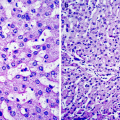and LI Ning2
(1)
Radiology Department, Capital Medical University Beijing You’an Hospital, Beijing, China, People’s Republic
(2)
Capital Medical University Beijing You’an Hospital, Beijing, China, People’s Republic
Abstract
Diagnostic imaging is an important way in clinical diagnosis of Influenza A(H1N1). Studies found that imaging demonstrations of Influenza A(H1N1) can be shown in its critical period. MRI of the nerves system demonstrates flaky long T2WI signals, with symmetrical cerebral white matter lesions; diagnostic imaging of the respiratory system demonstrates flaky shadows or parenchymal shadows, especially in the posterior basal segments of both lower lungs. The pulmonary infiltration can quickly develop into parenchymal changes, with occurrence of diffusive ground glass liked shadows or pulmonary parenchymal shadows in both lungs in a short period of time. Sometimes, it may cause complications like general organs failure. Diagnostic imaging findings of Influenza A(H1N1) are usually characteristic but not specific. And it should be differentiated in the diagnosis from HIV encephalopathy, heroin encephalopathy and ateriosclerotic encephalopathy. The commonly occurred critical Influenza A(H1N1) should be differentiated in the diagnosis from influenza, common cold, bacterial pneumonia, severe acute respiratory syndrome (SARS), chlamydial pneumonia and mycoplasma pneumonia.
Diagnostic imaging is an important way in clinical diagnosis of Influenza A (H1N1). Studies found that imaging demonstrations of Influenza A (H1N1) can be shown in its critical period. MRI of the nerves system demonstrates flaky long T2WI signals, with symmetrical cerebral white matter lesions; diagnostic imaging of the respiratory system demonstrates flaky shadows or parenchymal shadows, especially in the posterior basal segments of both lower lungs. The pulmonary infiltration can quickly develop into parenchymal changes, with occurrence of diffusive ground glass liked shadows or pulmonary parenchymal shadows in both lungs in a short period of time. Sometimes, it may cause complications like general organs failure. Diagnostic imaging findings of Influenza A (H1N1) are usually characteristic but not specific. And it should be differentiated in the diagnosis from HIV encephalopathy, heroin encephalopathy and ateriosclerotic encephalopathy. The commonly occurred critical Influenza A (H1N1) should be differentiated in the diagnosis from influenza, common cold, bacterial pneumonia, severe acute respiratory syndrome (SARS), chlamydial pneumonia and mycoplasma pneumonia.
13.1 Differential Diagnosis of Influenza A (H1N1) from Encephalopathies
13.1.1 Influenza A (H1N1) Encephalitis and HIV Encephalopathy
Both Influenza A (H1N1) encephalitis and HIV encephalopathy are actually cerebral white matter lesion. The pathomechanism of Influenza A (H1N1) encephalitis is the extensive ischemic injury of neurons as well as thrombosis of the brain stem and cerebellar pyramid secondary to cerebral edema. Extensive cerebral edema as well as vascular lesions and necrosis are the primary pathological changes. MRI demonstrations include flaky long T2WI signals of callosum and basal ganglia; linear T2WI around the lateral ventricle.
HIV encephalopathy is characteristically CD4+ lymphotropic and neurotropic. HIV selectively infects and destroys the CD4+ T-lymphocytes of the host, causing severe cellular immunity and consequently resulting in increased susceptibility to many opportunistic infections and neoplasms. HIV can cross the blood-brain barrier along with infected monocytes and macrophagocytes to directly infect brain parenchyma, especially glial cells, astrocytes and even microglia, consequently resulting in involvement of central nervous system. By CT scanning, HIV encephalopathy shows symmetrical bilateral large flaky low density areas in cerebral white matter, more commonly in the horn of lateral ventricle and at the cortico-medullary interface. Sometimes local flaky low density areas can be found. CT scanning also shows cerebral edema in its early stage, with no obvious space occupying effect and no enhanced manifestations by enhanced CT scanning. The total cerebral volume decreases in its middle and advanced stages, with deepened and widened sulci, enlarged sylvian cistern and enlarged cerebral ventricles. Local HIV encephalopathy shows decreased local brain tissues and fine gyrus. By MRI imaging, demonstrations include symmetrical spotty and large flaky long T1WI and long T2WI signals in the white matters surrounding bilateral lateral ventricles. In its early stage, cerebral edema can be found, with no obvious space occupying effect and no enhanced demonstrations by enhanced MRI. In its middle and advanced stages, the total cerebral volume decreases, with deepened and widened sulci, enlarged sylvian cistern and enlarged cerebral ventricles. Local HIV encephalopathy shows decreased local brain tissues and fine gyrus with long T1WI and long T2WI signals. DWI imaging demonstrates the white matters surrounding bilateral lateral ventricles have symmetrical spotty and flaky high signals. MRS demonstrates elevated lactate peak and inflammatory manifestations.
Stay updated, free articles. Join our Telegram channel

Full access? Get Clinical Tree




